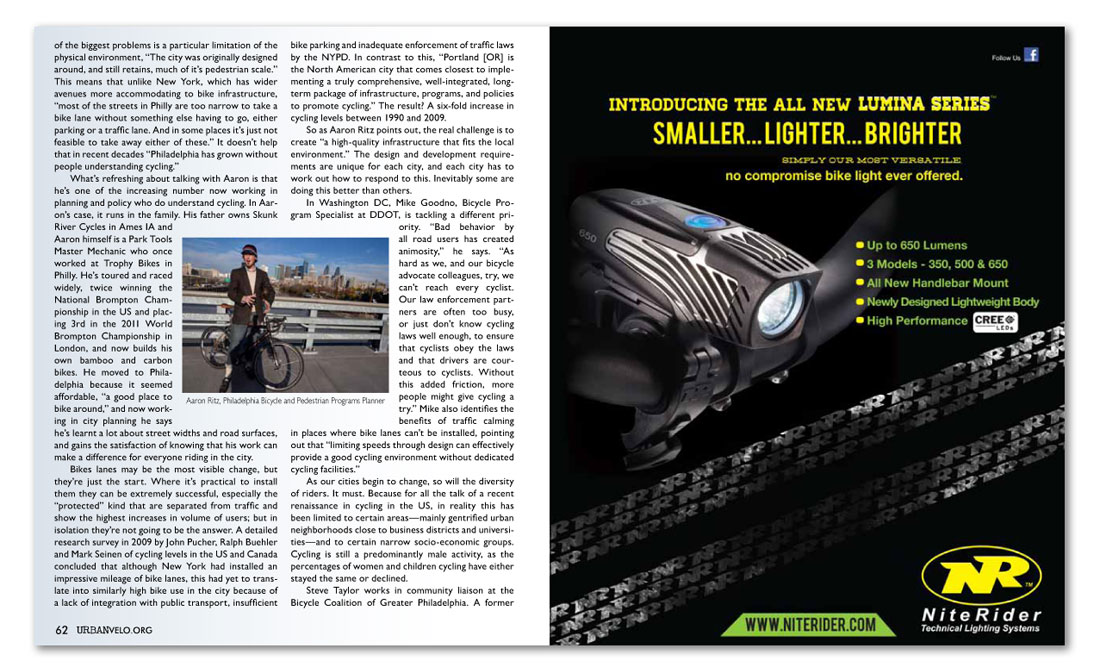


of the biggest problems is a particular limitation of the physical environment, “The city was originally designed around, and still retains, much of it’s pedestrian scale.” This means that unlike New York, which has wider avenues more accommodating to bike infrastructure, “most of the streets in Philly are too narrow to take a bike lane without something else having to go, either parking or a traffic lane. And in some places it’s just not feasible to take away either of these.” It doesn’t help that in recent decades “Philadelphia has grown without people understanding cycling.”
What’s refreshing about talking with Aaron is that he’s one of the increasing number now working in planning and policy who do understand cycling. In Aaron’s case, it runs in the family. His father owns Skunk River Cycles in Ames IA and Aaron himself is a Park Tools Master Mechanic who once worked at Trophy Bikes in Philly. He’s toured and raced widely, twice winning the National Brompton Championship in the US and placing 3rd in the 2011 World Brompton Championship in London, and now builds his own bamboo and carbon bikes. He moved to Philadelphia because it seemed affordable, “a good place to bike around,” and now working in city planning he says he’s learnt a lot about street widths and road surfaces, and gains the satisfaction of knowing that his work can make a difference for everyone riding in the city.
Bikes lanes may be the most visible change, but they’re just the start. Where it’s practical to install them they can be extremely successful, especially the “protected” kind that are separated from traffic and show the highest increases in volume of users; but in isolation they’re not going to be the answer. A detailed research survey in 2009 by John Pucher, Ralph Buehler and Mark Seinen of cycling levels in the US and Canada concluded that although New York had installed an impressive mileage of bike lanes, this had yet to translate into similarly high bike use in the city because of a lack of integration with public transport, insufficient bike parking and inadequate enforcement of traffic laws by the NYPD. In contrast to this, “Portland [OR] is the North American city that comes closest to implementing a truly comprehensive, well-integrated, long-term package of infrastructure, programs, and policies to promote cycling.” The result? A six-fold increase in cycling levels between 1990 and 2009.
So as Aaron Ritz points out, the real challenge is to create “a high-quality infrastructure that fits the local environment.” The design and development requirements are unique for each city, and each city has to work out how to respond to this. Inevitably some are doing this better than others.
In Washington DC, Mike Goodno, Bicycle Program Specialist at DDOT, is tackling a different priority. “Bad behavior by all road users has created animosity,” he says. “As hard as we, and our bicycle advocate colleagues, try, we can’t reach every cyclist. Our law enforcement partners are often too busy, or just don’t know cycling laws well enough, to ensure that cyclists obey the laws and that drivers are courteous to cyclists. Without this added friction, more people might give cycling a try.” Mike also identifies the benefits of traffic calming in places where bike lanes can’t be installed, pointing out that “limiting speeds through design can effectively provide a good cycling environment without dedicated cycling facilities.”
As our cities begin to change, so will the diversity of riders. It must. Because for all the talk of a recent renaissance in cycling in the US, in reality this has been limited to certain areas—mainly gentrified urban neighborhoods close to business districts and universities—and to certain narrow socio-economic groups. Cycling is still a predominantly male activity, as the percentages of women and children cycling have either stayed the same or declined.
Steve Taylor works in community liaison at the Bicycle Coalition of Greater Philadelphia. A former
NiteRider